The Bronx
The Bronx is the only New York City Borough that is located on the US mainland; Manhattan and Staten are both islands while Queens and Brooklyn are on Long Island. In 1639 a Jonas Bronck was the first recorded European settler in the area when he established a farm along the Harlem River. The Aquahung River, which ran through his land, became known as Bronck's River. In time the spelling of the river changed to Bronx River. In 1874 the area to the west of the Bronx River including the towns of Kingsbridge, West Farms, and Morrisania was annexed to New York City and documents referred to this area as ‘the Annexed District of The Bronx’. In 1895 the territory to the east of the Bronx River was annexed to New York City then in 1898 New York City was consolidated with the Bronx as one of its five Boroughs. While there was some suburban development near the railroad lines, The Bronx was still a relatively rural area, providing food for the ever expanding urban area on Manhattan Island. The arrival of the Subway after World War I began the process of transforming The Bronx into an urban area. Many French, German, and Polish immigrants settled in the borough and there was a sizeable Jewish population. The Bronx was always a relatively poor area and between the 1960s and early 1980s it went into decline with frequent arson attacks. Since then an Urban Renewal project has significantly improved The Bronx, but there are still some very poor areas.
Haupt Conservatory, New York Botanical Garden
Columbia University botanist Nathaniel Lord Britton and his wife Elizabeth visited the Royal Botanic Gardens, Kew, London while on their honeymoon in 1888. They decided that New York needed to have a similar world-class botanical garden. On their return home they started a campaign which in 1891 resulted in New York State chartering a botanical garden. In 1895 Britton chose a City owned site of old growth forest where the Bronx River flowed through a rock gorge. Calvert Vaux, the co-designer of Central Park, was engaged to prepare the initial design. The New York Botanical Garden opened to the public in 1900 with Britton as its first director. One of the best known features of the Royal Botanic Gardens in Kew is the conservatory known as the Palm House and Britton wanted the New York Botanical Garden to have a similarly imposing structure. The conservatory took three years to build, opening in 1902. It was renovated in 1935 and 1950 but by the 1970s it was in a state of serious disrepair and was under threat of demolition. Publisher Enid A Haupt provided $5m to renovate the conservatory and a $5m endowment to maintain it. Not only did this save the conservatory but it also allowed changes made during previous renovations to be reversed. The Conservatory was named the Enid A. Haupt Conservatory in 1978.Click Tab 2 to see some desert plants in the conservatory.
Goldman Stone Mill, Bronx River, New York Botanical Garden
This mill standing on the Bronx river is nowadays in the middle of the New York Botanical Garden, but it pre-dates the garden by a considerable time. In 1760 Pierre Lorillard founded a tobacco company in Lower Manhattan but he was killed during the Revolutionary War. His two sons, Peter and George, took over the business and in 1792 they moved it to this location. They built this mill around 1840 to grind tobacco into snuff. The mill operated until about 1870, when the company moved to New Jersey, and the Lorillard Snuff Mill was abandoned. In 1937 the building was officially acquired by the New York Botanical Garden. The building was extensively restored in 2010 and is now called the Lillian & Amy Goldman Stone Mill. It can be rented for events such as weddings.
DLU100601
Click on Minimap to navigate
Home > US States > Midatlantic USA > New York > New York City >
'Abbey Violet Macchia Set' Chihuly Glass, Mertz Library, New York Botanical Garden
Having visited the Royal Botanic Gardens in Kew during his 2005 exhibition there, it was wonderful coincidence that renowned glass sculptor Dale Chihuly was exhibiting during our 2017 visit to New York Botanical Garden. In the picture above his work 'Sol del Citron' is visible in front of the Haupt Conservatory. There were more sculptures inside and behind the conservatory. The piece in this picture entitled 'Abbey Violet Macchia Set' is one of several on display in the Mertz Library at the garden. Click Tab 2 to see the 2014 Chihuly glass sculpture 'Float Boat' in the Native Plant Garden.
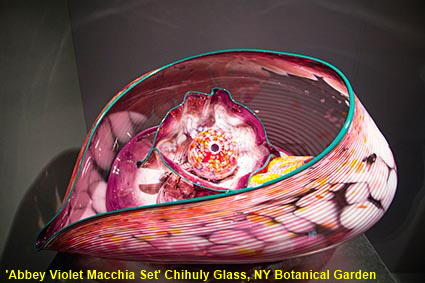
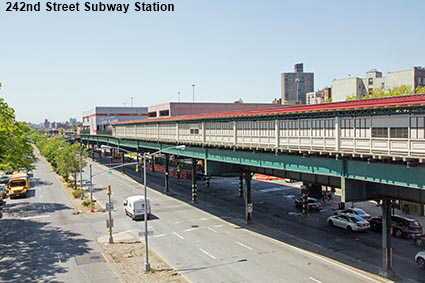
242nd Street Subway Station
Subway Line 1 runs from South Ferry in Lower Manhattan all the way up to 242nd Street in The Bronx. Nowadays elevated railways are mainly associated with Chicago and those who have never ventured beyond the tourist areas of Manhattan are likely to be completely unaware that the outer regions of the New York Subway run on elevated tracks. At 242nd Street the elevated line comes to an abrupt halt although the design of the station does suggest that further extension of the line was envisaged, but never implemented.
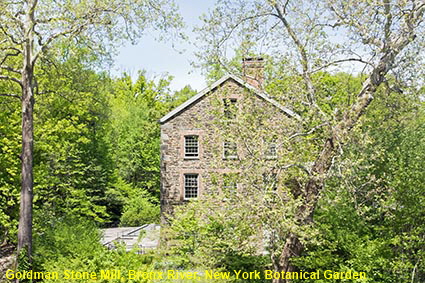
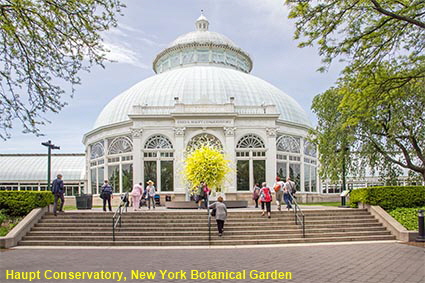


To move forwards or backwards through the New York City trail click the arrows above, or select your next destination on the Minimap.
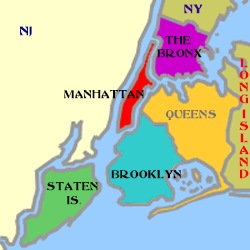
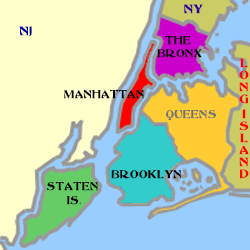
Van Cortlandt House Museum, Van Cortlandt Park
This Georgian style house is the oldest building still standing in The Bronx. Frederick Van Cortlandt began construction of the house in 1748 on the plantation that his family had owned since 1691. Sadly Frederick died in 1749 before the house was completed. His will passed the plantation to his son, James Van Cortlandt, but also gave his widow, Frances, a lifetime tenancy in the house. Rochambeau, Lafayette, and Washington all used the house during the Revolutionary War. In 1887 the Van Cortlandt family sold the plantation to the City of New York to create a public park. This created a problem of what to do with the house. In 1895, recognising the historical significance of the house, the National Society of Colonial Dames in the State of New York proposed that they should restore it as a house museum and open it to the public. This required a change in the law because at that time New York State Law did not allow publicly owned buildings to be run by private organizations. The Colonial Dames persevered and in 1896 the law was changed. Van Cortlandt House Museum opened on May 25, 1897 and it remains a house museum to this day. Click Tab 2 to see the West Parlor or Tab 3 to see the Dutch Chamber.
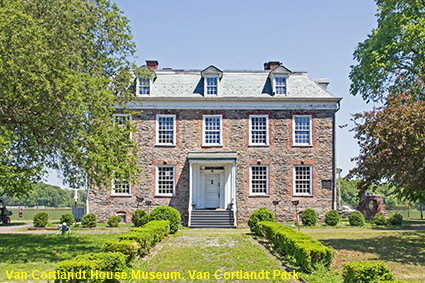
© Mike Elsden 1981 - 2025
The contents of this page may not be reproduced in full or in part without permission